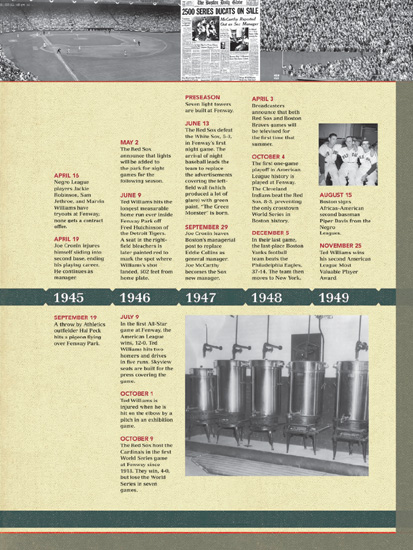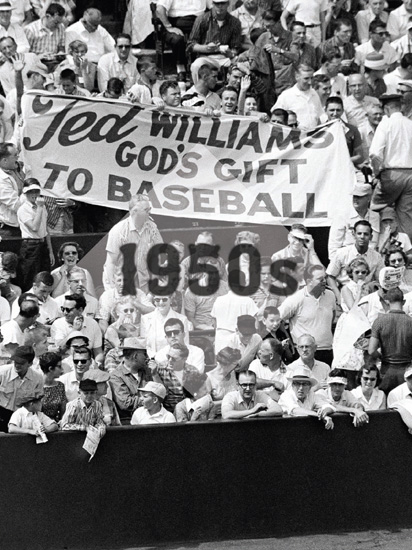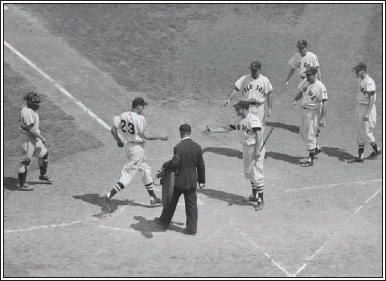Fenway Park (25 page)
Authors: John Powers



A
s the baby boom got into full swing, so did Boston’s bats. The Red Sox put up one of the top offensive seasons of all time in 1950, scoring more than 1,000 runs for the only time in their history and batting over .300 as a team. But characteristically, the pitching staff had a bloated ERA (4.88), and the Sox finished four games behind the Yankees in third place. This combination of powerful offense and mediocre pitching kept the Red Sox in the top half of the league through most of the decade, but they never placed higher than third. So it went, with the Sox either staying in contention long enough or reviving late enough to keep interest alive among their saddle-shoed, flattop-wearing fandom. In 1955, for example, they crept up from sixth in May to fifth in June to fourth in July and were only three games back on Labor Day before losing 12 of 14. Boston’s two major-league clubs, the Sox and the Braves, collaborated to host clinics for aspiring ballplayers in 1952, and when the Braves left town for Milwaukee at the end of that season, the Sox continued the practice, which lasted well into the 1970s. The 1950s at Fenway also featured the Harlem Globetrotters’ hoop shtick on a basketball court set up in the infield, and some not-so-funny antics from Sox outfielder Jimmy Piersall, who overcame mental illness to eventually earn a spot in the team’s Hall of Fame. Meanwhile, the team was overcoming its sad racial legacy by adding a pair of African–American players near the decade’s end to become the last Major League Baseball club to integrate its roster.
T
he tease resumed at Fenway Park in the 1950 opener when Boston ran up a 9-0 lead, imploded, and lost, 15-10. Scoring runs wasn’t a problem for a bunch of bashers who led the league in batting average (.302), runs (1,027), and homers (161). In one June week, the Sox pounded out 104 runs, 49 of them in a two-game pummeling of the St. Louis Browns at Fenway, during which the hosts broke five major-league records.
“Hot lava bubbled in the batter’s box when the Red Sox had their innings,” the
Globe
’s Harold Kaese reported after a 20-run explosion. There was an even bigger volcanic eruption the next day when Sox second baseman Bobby Doerr hit three homers and drove in eight runs in a 29-4 win in which Boston was up, 20-0, after four innings, having batted around three times.
Yet Browns Manager Zach Taylor was unimpressed. “Pitching wins pennants,” he declared, “and pitching is what the Red Sox will need more of if they aren’t going to have another battle on their hands this season.” St. Louis bashed the Sox, 12-7, the next day, and then Detroit laid on an 18-8 whipping. After subsequently being banged around in Cleveland, Detroit, and Chicago, the club had dropped to fourth place.
It was enough to drive a manager to drink, and Red Sox Manager Joe McCarthy, a notorious tippler in the best of times, had become all but legless and soon was gone for what were described as health reasons. “When a man can’t help a ball club any more, it’s time to quit,” said McCarthy, who was replaced by third-base coach Steve O’Neill and never managed again.
The Sox were world-beaters at Fenway, their angular playpen. When his club was out of town, Yawkey delighted in putting on a threadbare team jacket and wrinkled khakis and taking personal batting practice with new balls. “I hit the Wall eight times today,” he’d brag. But Joe Cronin, who’d played shortstop for a decade and managed for another dozen years before becoming the Sox general manager in 1947, hated the cozy confines. “Trying to build a ball club here is almost impossible. You build it for here, you lose on the road; you build it for the road, you lose here,” said Cronin, who called it a “pissy ballpark.”
The Sox were 39-38 away from home that season but 55-22 in their yard, where they went 16-1 during an August home stand to draw within a game of the lead, even though Ted Williams was sidelined with a splintered elbow that he’d sustained by running into a wall at Comiskey Park during the All-Star Game. But Boston struggled on the road, including an 8-0 blanking at New York on September 23, and was extinguished at Fenway by the Senators, who swept them in a Wednesday doubleheader as Boston was shut out at home for the first time in two years. “The ignominy of the Red Sox demise yesterday will not soon be forgotten in these precincts,” Kaese wrote as the club went on to finish third behind New York.
Yet the fandom happily succumbed to temporary amnesia in 1951 when the Sox surged past New York and into first place just after the All-Star break. “Hey, looks like we’ll be in the World Series THIS year, baby,” clubhouse attendant Johnny Orlando taunted Joe DiMaggio as the Yankees quietly filed through the home clubhouse on their way to the bus after having been swept in early July. “Long ways to go, John,” DiMaggio reminded him. “Don’t count your money. Long ways to go.”
Boston remained aloft, thanks to Clyde Vollmer, who’d apparently struck a Faustian bargain on Independence Day. “Dutch the Clutch” crammed an entire career into one month, hitting 13 homers and driving in 40 runs and hitting safely in 16 straight games in July. But when he returned to earth in August, so did his teammates, and the season ended with a brutal five-game sweep in New York, where fireballer Allie Reynolds no-hit the Sox in the series opener to clinch the pennant. Boston ended up third, 11 games out.

Mel Parnell made his pitching delivery wearing skis after the Red Sox home opener against the Washington Senators was postponed by a snowstorm on April 14, 1953. Parnell went on to win 21 games for the Red Sox that season. He pitched 10 seasons, all with Boston, and threw a no-hitter in 1956.

Clyde Vollmer crossed home plate after delivering a big hit for the Red Sox in July 1951.
Yawkey, who’d never seen his club held hitless, didn’t stick around to watch Yogi Berra catch Williams’s foul pop-up for the final out just after the catcher had dropped one. “Even he couldn’t stand the sight of the once proud team stumbling all over the stadium,” Bob Holbrook wrote in the
Globe
.
Terminal summer siestas had become the norm for the Sox and after Williams was recalled to duty by the Marines at the end of April 1952 to fly a fighter jet in the Korean War, it seemed possible that they might go dormant before the solstice. Yet one combustible personality took up for the other as rookie Jimmy Piersall put the club in first place in early June with a bit of clownish agitation that was as worrisome as it was entertaining.
His target was Satchel Paige, the St. Louis pitcher whose age (allegedly 46) was little more than a random number. “Satchmo, I’m going to bunt on you. And then watch out!” Piersall shouted as he came to the plate in the ninth inning with Boston trailing, 9-5. After he’d reached safely and advanced to second, Piersall began flapping his arms and making porcine grunts. “Oink, oink, oink,” he snorted. After a walk moved him to third, Piersall resumed his taunting: “You look awful funny to me. Oink, oink, oink. Gosh, but you look funny out there on the mound.”
Paige, who hadn’t allowed a run in more than 26 innings and was renowned for his imperturbability, clearly was rattled. He walked Billy Goodman to force in Piersall, and then served up a grand slam to Sammy White to give his hosts a most improbable 10-9 triumph as White crawled across the plate on all fours. “I don’t care what anybody thinks about what I was doing,” Piersall proclaimed. “We won the ball game, right?”
HE WAS “DUTCH THE CLUTCH”
One July, a journeyman ballplayer had a month that rivaled nearly any that the game has ever seen. It wasn’t just that Clyde Vollmer had a lot of hits for the Red Sox in July 1951, but that nearly every one seemed to win a game for Boston.
“I’ve never seen anybody come through like Vollmer—and I mean nobody,” said then-Red Sox first-base coach Earle Combs, who had once teamed with Babe Ruth and Lou Gehrig in the Yankees’ legendary Murderer’s Row lineup.
Vollmer would never again come close to duplicating the heroic performances of those four weeks, during which he would become known as “Dutch the Clutch.” Vollmer clubbed as many home runs as singles—13 of each—along with a triple and four doubles, while compiling a 16-game hitting streak. Though his batting average during the spree was a less-than-stunning .298, almost every hit was a key one—including a pair of grand slams off two of baseball’s top pitchers.
“That month belonged to Vollmer as no single month has ever belonged to a major leaguer before or since,” Red Sox broadcaster Curt Gowdy later recalled in a
Globe
story by George Sullivan.
Vollmer, 29, was obtained from Washington a year earlier as a backup outfielder and pinch hitter. During his memorable month, he drove in 40 runs and scored 25 more to almost single-handedly lift the Sox into first place.
Fittingly, his explosion began on July 4, when he homered in the first game and singled in the nightcap as the Sox swept a doubleheader from the Philadelphia A’s.
On July 7, Vollmer ripped a first-inning slam off Yankee ace Allie Reynolds to ignite a 10-4 rout of New York at Boston. From July 12-14, the Red Sox took over first place from the White Sox by winning three out of four at Chicago in a series that featured Vollmer’s clutch hitting in all four games.
The binge continued for two more weeks and included a three-homer, six-RBI game at Fenway on July 26. On July 28, he had a single in the 15
th
inning to tie the score against Cleveland at Fenway, and then rocked a grand slam off Bob Feller, baseball’s top pitcher of the time, to win it an inning later. But at month’s end, Vollmer dramatically struck out in the last of the ninth inning as the Sox lost to the Indians, 5-4.
As Vollmer faded, so did the Red Sox. They finished third, 11 games behind the Yankees and five behind the Indians. By season’s end Vollmer had reverted to his lifetime average of .251. And by early 1953 he was sold back to Washington, where he finished his major league career a year later.
“Those were my happiest years in baseball,” Vollmer said later. “Coming to the Red Sox was the greatest break I ever got.”